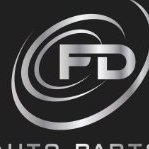-
Welcome to Auto Parts Forum
Whether you are a veteran automotive parts guru or just someone looking for some quick auto parts advice, register today and start a new topic in our forum. Registration is free and you can even sign up with social network platforms such as Facebook, X, and LinkedIn.
Engine knock
-
Similar Content
-
- 7 replies
- 664 views
-
- 0 replies
- 441 views
-
- 0 replies
- 457 views
-
- 0 replies
- 708 views
-
- 1 reply
- 814 views
-
-
Similar Topics
-
By Mighty Auto Parts
The post
link hidden, please login to view appeared first on link hidden, please login to view. When diagnosing engine performance complaints such as misfire symptoms, be advised that several systems and components can contribute to those symptoms. When considering single or multiple misfire codes, some checks may seem farfetched but trust me if not all are considered the symptoms can elude the most experienced technician, resulting in a misdiagnosis. When this […]
The post
link hidden, please login to view appeared first on link hidden, please login to view.
link hidden, please login to view -
By Counterman
Theory can only take you so far when formulating engine oil. Complex modeling is an important step, but it can’t duplicate the magic that happens inside the cylinder. Operating conditions, duty cycles, driver behavior—it all impacts how an engine ages. As it does, deposits form within the engine. The carbonaceous compounds that form on various engine components, including pistons, valve trains, and timing chain covers are a natural occurrence; a consequence of aging that result from the breakdown of oil components at high temperatures, particularly during the combustion process. The highest temperatures occur on the metal surfaces within the engine, where these deposits tend to adhere.
“There are some deposits that are temporary that you can wipe off with your finger, and there are others that can get very thick,” explained Dr. Michael Warholic, global technology director, Valvoline Global Operations. “The bad thing about deposits—and actually there are several bad things—are that, first of all, they insulate and you can’t get the heat out.
“They also cause friction.”
Friction is exceptionally bad, especially if you’re formulating oil. Thick deposits can clog oil passages, restricting the flow of oil to critical engine parts. This leads to inadequate lubrication, exacerbating wear and potentially causing engine failure. Traditionally the role of engine oil has been to slow down engine deposit development, but in concocting its latest engine-protecting blend, the Valvoline team stumbled upon something … surprising.
“We were trying to basically minimize deposits, engine wear, friction and heat, and oil formulation is a balance, so you have to pick and choose what you want it to do,” Warholic explained. “What we didn’t know was before the testing that it would remove and reverse the process–that is something you can’t predict by modeling. Restore and Protect removed engine deposits.
“I had never seen anything like it before, and I have eight years at Valvoline and 16 years at a company that makes the additives used in oil formulation.”
Valvoline’s Restore and Protect is a fully synthetic motor oil that aims at both older, high-mileage vehicles (restore) and new vehicles (protect). While Warholic was tight-lipped about the specific blend of additives within the oil, Valvoline has noted two proprietary technologies–Active Clean, which removes deposits and Liqui-Shield, which prevents deposit formation.
It’s not just marketing—at a recent event, Valvoline put Restore and Protect-cleaned pistons on display. Take a look:
Valvoline validates its oils through industry standard tests such as the GF-6 SP specification, which uses a Chrysler Pentastar engine to measure deposit formation. These tests provide a benchmark for oil performance, ensuring that the oil meets or exceeds industry requirements.
“Exceeds” is the key word. Warholic was quick to point out that these types of tests are merely the baseline within the oil market, not the high bar that oil manufacturers should seek to leap over.
“We want to exceed the API specifications and excel in all categories. Restore and Protect is already GF-7 capable, which is great,” he said.
Real-world testing is crucial. For instance, a Ford Mustang was subjected to extensive testing with Restore and Protect, showing significant reductions in wear and deposit formation. The testing extended to various engine components, including the timing chain cover, oil pan, and valve train, demonstrating the comprehensive benefits of the oil. The team also ran Restore and Protect in a Ford Explorer with more than 500,000. “And we also did a chassis dynamometer test where we put a vehicle on rollers basically and ran it 300,000 miles,” Warholic said. “Restore and Protect actually cleaned up the entire engine.”
For automotive aftermarket professionals, understanding the use of high-performance oils can lead to better engine health, improved engine operating efficiency, reduced maintenance costs and happy customers.
“We’re trying to maximize engine life,” Warholic said. “Vehicles are getting older. The vehicle life on the road is getting older. Vehicles may change owners and engines are going to be running longer. For us, it’s about maximizing engine performance so that you don’t lose fuel economy, you don’t lose efficiency, and you don’t break down on the highway.”
The post
link hidden, please login to view appeared first on link hidden, please login to view.
link hidden, please login to view -
By Counterman
hatever happened to engine colors? Every manufacturer had their own specific hue. Orange, blue, red, gold…there were lots of options. Purists get serious about it too. If you’re going to pop the hood at a car show, the color better be right.
link hidden, please login to view At the risk of sounding partial to the classics, I’m going to say I miss those days. The majority of the engine blocks were clearly visible, and air cleaners, brackets, braces and pulleys all had a nice finish, only to be topped aesthetically on performance models with chrome-plated air cleaners or valve covers.
Under the hood, there was something nice to look at, adding incentive to clean and degrease the engine on a regular basis. If you were from my generation, when you got a new (used) car, one of the first things you did was clean the engine and engine compartment. Having a clean mill under the hood was just an extra way to take pride in your car.
Open the hood on today’s cars and you get plastic, then more plastic. Finished in less-than-exciting flat black, with the occasional glimpse of an aluminum cylinder head, there’s just not as much to get excited about when it comes to cleaning your engine. But, is it important? You bet.
link hidden, please login to view There are plenty of theories surrounding whether or not it can affect the performance, and even question if a clean engine will run cooler. The fact is neither is true. I always think my cars run better after waxing them, but I know that’s scientifically impossible, so I chock that up to the car’s “soul.” I’ve never experienced a situation where a dirty engine makes it run worse. Engines just don’t care.
Some might argue that layers of grease and grime can prevent heat dissipation from the engine, and while you could probably prove that scientifically, in practice, it makes no difference. If there is reality to that, it would be in such minor fractions of a degree that it simply wouldn’t matter.
Where it does matter is that leaks, both coolant and oil, are the primary contributors to a dirty engine. The fluids themselves build up and coat the engine, as well as other parts of the car depending on the severity of the leak, and this creates many problems. One, it makes it difficult to find the source of the leak. As a technician, there are times when an engine is so dirty, you have to clean it first before you can pinpoint a leak.
The other consequence is these fluids getting onto other components. Oil wreaks havoc with rubber, and can soften coolant hoses, engine mounts, belts, weatherstrips and even electrical connector weather seals. Finally, the oil buildup traps dirt and before you know it you can have a thick layer of oily, greasy grime that will come off in huge chunks.
A little dust never hurt anything, but it’s amazing how much “stuff” comes up off the road and settles in the engine compartment. Dirt, rocks, asphalt, leaves, you name it, it will find a way in. The problem with debris is that it can fall into the engine when replacing things like spark plugs or valve cover gaskets, or even when doing something as simple as the air filter or adding oil. There’s a lot of damage that can occur if this happens.
The final benefit to cleaning your engine is it allows you to evict any rodents that may be residing in one of the many cozy spots under the hood, just waiting to chew their way into an expensive repair.
So, when your customer asks about cleaning an engine, not only can you give them good reasons, but you can offer them solutions and know-how to ease their concerns about the often-told story of cleaning an engine and experiencing a no-start situation afterward. With a few simple precautions, they won’t have any trouble.
My starting point begins with access. On most vehicles today, there’s almost always a plastic cover on the top of the engine, which I might mention hides a lot underneath, and the engine is often dirtier than you realize. I remove all of these covers, and if the vehicle has a lower engine cover, I remove these as well, since they’ll just hold everything you clean off the engine.
link hidden, please login to view The first step in the cleaning process belongs to compressed air and a blow gun. Large amounts of debris such as leaves or the occasional mouse nest can be sucked out with a shop vac, or just grabbed out by hand and thrown away. But a blow gun will take care of all of it. I’m always sure to wear safety glasses and a dust mask, then I work my way from top to bottom of the engine and compartment, blowing out all dust and debris, focusing on areas that typically trap a lot, such as around the spark plugs and intake manifold.
As I work my way down, I blow debris off the frame, suspension and body parts that are accessible, and also off the top of the transmission, since it will trap a lot. Finally, I blow out the radiator and condenser fins (which by the way CAN affect engine temperature and A/C performance). You’d be surprised how much dirt comes out of these.
With the bulk of the debris removed, it’s time for degreaser. The first step here is to cover any electrical components that will be affected by water, such as the alternator and distributor, if equipped, as well as the intake duct for the air cleaner, or any exposed air filter. I use plastic disposable grocery store bags for this. Keep in mind two things here. One, most things are sealed up, and it’s not uncommon to have water splash up when you drive in the rain. Cars are built to handle this. But two, this is just incidental water splashing and nothing is meant to have pressurized water sprayed at it, sealed or not, so as long as you cover electrical components, and don’t spray directly at any of them, you won’t have a problem. Just be careful with high-pressure power washers.
Now it gets simple. I put cardboard under the car to collect the drippings that are about to occur, then spray the engine, as well as surrounding components with degreaser, and let it soak. It’s always a good idea to read the instructions for the degreaser to beware of any damage it could cause to anything such as the vehicle paint. After the degreaser has had time to soak, I use a cleaning brush to scrub the excessively dirty areas, and, in some cases, a scraper may be required when there’s a lot of buildup.
I tend to use a second application of degreaser, and let it soak, then scrub some more before rinsing it off. Then, I remove the cardboard and put a large plastic tub underneath to catch the big clumps of grease that may wash off. When rinsing things, I use light spray around electrical components, and limit the full force of the hose nozzle to the block, heads and intake, or anywhere there’s serious grease removal.
link hidden, please login to view A final trick I use is to hook up the hose to hot water, when possible. If you have a utility sink, you can get adapters that allow you to do this. Hot water makes a huge difference in cutting through the grease, but you’ll use a lot of it, so if you’re at home, I never start the job just before someone needs a shower, or you might end up in a different type of hot water.
With everything cleaned up, remove all the protective plastic coverings, blow off any excess water that’s puddled up anywhere, reinstall any covers you removed, and you’ve just done your car a favor.
Why wait for the occasional customer who asks about cleaning their engine? Spring cleaning is good under the hood, too. Latex gloves, dust masks, safety glasses, engine degreaser, cleaning brushes, a blow gun, hose nozzle, plastic tub, absorbent mats and shop rags are all great supplies you likely have in stock. Finish it off with some microfiber towels and a spray detailer to wipe any surround paint surfaces, just in case any solvents splash out.
The post
link hidden, please login to view appeared first on link hidden, please login to view.
link hidden, please login to view






Recommended Posts
Join the conversation
You can post now and register later. If you have an account, sign in now to post with your account.
Note: Your post will require moderator approval before it will be visible.